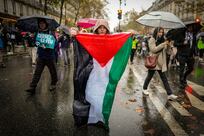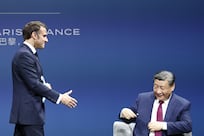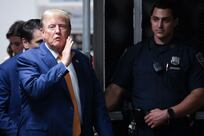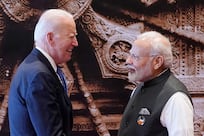Barely four days after smiles and handshakes on the border of the demilitarised zone that divides the two Koreas, the walls have gone up once again. North Korea has accused the US of being "hell-bent on hostile acts" and said it was "obsessed with sanctions". Pyongyang has taken particular umbrage with the fact that at the same time as US President Donald Trump was pressing the flesh with North Korean leader Kim Jong-un, Washington was adding its name to a joint letter, together with the UK, France and Germany, calling on UN member states to abide by sanctions on North Korea.
So has all the goodwill of Sunday's impromptu summit between Mr Trump and Mr Kim completely evaporated – or is there still an impetus for the US president to triumph yet in extracting a deal on denuclearisation from North Korea? No other US president has successfully managed to do so. Indeed, bad faith and cheating are endemic to US-North Korean negotiations – and not just on the Korean side. In the 1990s, the US government dragged its feet over implementing a deal known as the Agreed Framework, which would have seen Pyongyang freeze the escalation of its nuclear weapons programme in exchange for two proliferation-resistant nuclear power reactors. It broke down when US intelligence discovered North Korea was enriching uranium. Amid strained relations, the deal was scrapped by the Bush administration in 2003 and North Korea withdrew from the Nuclear Non-Proliferation Treaty. John Bolton, who was then undersecretary of state for arms control and international security, said it was "the hammer I had been looking for the shatter the Agreed Framework".
Both sides suffer from massive commitment problems. Each deeply distrusts the other, not only for obvious ideological and strategic reasons but based on past behaviour. The status quo of continuing hostility is deeply set.

The previous US administration of president Barack Obama was committed to maintaining the status quo. But for one effort in 2012 called the Leap Day Deal, which would have involved a moratorium on North Korea’s nuclear weapons and ballistic missiles programme in exchange for food aid and concessions, Mr Obama was content with what he called “strategic patience”. The US would contain, deter, isolate and sanction North Korea. Ideally this tightening vice would encourage the country to negotiate. But in practice, this meant holding firm to US-South Korean containment of North Korea going back to the 1950s.
Mr Trump entered office determined, apparently, to up-end this status quo. By 2017, North Korea had attained both an intercontinental ballistic missile which could reach the US and a fusion nuclear warhead – one with 50 times the energy released in the 1945 Hiroshima bombing. North Korea could now strike America with a very powerful weapon. Mr Trump felt compelled to respond.
His first effort was to veer to the right, to follow the counsel of the hawks in his administration and threaten force. In 2017, the Korean peninsula was racked by the worst crisis since the Korean War. Rumours were rife that various US exercises were actually practice drills for pending airstrikes. The Japanese government practiced air raids. In South Korea, my wife and I stocked a “go-bag” packed with money, water and crackers.
Mr Trump’s hawkish line toward North Korea was deeply unpopular though in South Korea. No US strike on the North would spare the South. Northern retaliation would likely fall on the South. And if strikes escalated into full-scale warfare, possibly involving nuclear weapons and neighbouring countries such as China, Russia and Japan, South Korea would be obliterated in the crush.
So severe was southern anxiety that South Korean President Moon Jae-In publicly stated that the US could not attack North Korea without South Korea’s permission. No South Korean president had ever asserted a veto right over the US use of force and Mr Trump would certainly have ignored it. But it symbolised the deep crisis that Mr Trump’s “fire and fury” threats had created.
Then, as suddenly as it began, the crisis ended when Mr Trump flip-flopped to the left, adopting a dovish diplomatic approach. In March 2018, Mr Trump abruptly announced he wanted to meet Mr Kim personally and even started hinting that he deserved a Nobel Peace Prize.
Since then, Mr Trump and Mr Kim have met three times – in Singapore in 2018, in Hanoi early this year and in the inter-Korean demilitarised zone last weekend. Mr Trump has a great sense for televisual drama and theatricality. The summits have made for gripping viewing, arguably infotainment as much as diplomacy. But for all the grand imagery, such as Mr Trump becoming the first US president to set foot inside North Korea, he has still not extracted a deal on the core strategic issues which divide the North from the South and the US.
What are those issues? They fall into two broad categories – the political issues of the regime itself, and strategic or military issues in the regime’s relationship with the outside world, especially South Korea and the US. Political issues include the appalling human rights situation in North Korea, which the definitive United Nations report on this issue compared to Nazi Germany, as well as the Kim family monarchy, the extremely repressive police state apparatus and the quasi-theological cult of personality. These issues are very hard to change, as they cut to core of the regime’s identity. Not surprisingly, the Trump administration has unceremoniously dropped human rights from its rhetoric since that first meeting with Mr Kim.
Strategic issues include questions of the intra-peninsular military balance. North Korea now has several dozen nuclear warheads, hundreds of missiles with various ranges, mobile launchers from which to project those missiles and a massive forward conventional deployment of the North Korean People’s Army flush against the South Korean border.
Analysts expect little movement on core political identity issues but Mr Trump and Mr Moon have both raised expectations repeatedly on strategic issues. Yet so far, North Korea has not given up one warhead or missile. Despite all the talk since March 2018, there has been very little empirical movement on the ground. North Korea might no longer be testing weapons, which Mr Trump hails as a success, but it is now producing warheads and missiles. Every day, the problem grows worse.

Mr Trump’s approach seems to be that if Mr Kim perceives him to be a friend, then the North Korean leader will make strategic concessions because he trusts him. This is a very unusual national security method and one likely to fail. It would be remarkable for a nuclear power to denuclearise on such terms. Nothing like that has ever happened before. Far more likely is that North Korea simply retains its arsenal or trades only part of it in return for US concessions.
Specifically, North Korea’s nuclear armament presents the US with several possible options, all of which have considerable downsides. One is coercion. If the US flatly refuses to accept North Korea as a state with nuclear weapons, the only way to fully denuclearise it is by force. Mr Trump flirted with this idea in 2017 and extremely hawkish US advisers such as Mr Bolton and HR McMaster endorsed strikes. The downside is, of course, enormous. Bombing North Korea into submission is quite likely to ignite a major regional conflict, possibly involving the very nuclear weapons it is intended to eliminate.
Another option is adaption and simply accepting North Korea as a nuclear weapons state. The US has tolerated the nuclear weapons of Maoist China, Pakistan, India and Israel, despite its obvious discomfort. None have used their nuclear weapons to pursue offensive strategies or nuclear imperialism. It is likely North Korea would also retain its weapons for defence rather than offence.
If the US is unwilling to live with a nuclear North Korea, but also unwilling to coerce it, then it must trade with Pyongyang. I see two possible trades or bargains: a weapon-for-weapon swap, in which the US gives up regional strategic assets such as US air wings, or units of command, at airbases in South Korea, in exchange for North Korean missiles or warheads or both. Or the US could effectively buy Pyongyang’s missiles and warheads in an arrangement akin to the 2015 Iran nuclear deal, whereby the US gives North Korea huge financial incentives, sanctions relief, development aid, cash and access to the global banking system.

Paying North Korea for its weapons is strategically superior to withdrawing US assets. The latter would have massive political regional consequences, signalling to all regional players that the US was retreating from East Asia. Simply paying North Korea is politically far easier, as money comes with no strategic ramifications. It is still odious; it feels like blackmail. But buying them is a better choice than war or a weapon-for-weapon swap. All choices here are bad.
I believe ultimately Mr Trump will either seek a cash and aid-for-nukes deal, or simply drop the North Korean nuclear issue and learn to live with a nuclearised Pyongyang.
Finally, the regional implications of a major Trump-Kim deal would be large. If the president can pull it off, it could well end the hostile relationship between the US and North Korea. China would be elated, as it wants North Korea to survive but not pursue unchecked nuclearisation. Russia too would likely support a negotiated outcome. It also wants Korea to remain divided and not unified in the American camp. More tentative would be the Japanese response. Japanese Prime Minister Shinzo Abe supported Mr Trump’s 2017 belligerence and is hawkish on North Korea. The Japanese support unification in order to finally eliminate the long-term North Korean menace. A breakthrough Trump-Kim deal would essentially recognise North Korea as a permanently independent state. As the North will not give up all its missiles, Japan would then have to live permanently with a North Korean missile threat.
So much depends on Mr Trump’s “art of the deal”. So far he has not convinced Mr Kim to give up anything valuable. Despite the symbolism, the situation on the ground in Korea is unchanged. Mr Trump is under pressure to act soon. The US election is coming up and he wants a successful North Korean deal as a useful campaign tool, hence his inviting Mr Kim to the White House. But that gives Mr Kim a strong incentive to wait until the US president is more desperate for a deal. The so-called “flower of peace” is unlikely to be blossoming any time soon.
Robert Kelly is professor of international relations in the department of political science and diplomacy at Pusan National University, South Korea





